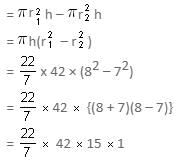Indian Air Force Agniveer Science & Other than Science Mock Test - 4 - Indian Air Force Agniveer Vayu MCQ
30 Questions MCQ Test Indian Air Force Agniveer Vayu Group X Mock Test Series 2025 - Indian Air Force Agniveer Science & Other than Science Mock Test - 4
A bus is moving with a speed of 10 ms–1 on a straight road. A scooterist wishes to overtake the bus in 100 s. If the bus is at a distance of 1 km from the scooterist, with what speed should the scooterist ch ase the bus? [2009]
In a Carnot engine 800 J of heat is absorbed from a source at 400 K and 640 J of heat is rejected to the sink. The temperature of the sink is:
The cyclotron frequency vc is given by
An AC generator consists of
What is the value of cos 41π/4
Express the following in standard form : (2 – √3i) (2 + √3i) + 2 – 4i
Find the points on z-axis which are at a distance  from the point (1, 2, 3).
from the point (1, 2, 3).
The distance between the lines 5x – 12y + 65 = 0 and 5x – 12y – 39 = 0
The centre and radius of the circle x2 + y2 + 4x – 6y = 5 is:
Determine whether the given planes are parallel or perpendicular, and in case they are neither, find the angles between them.7x + 5y + 6z + 30 = 0 and 3x – y – 10z + 4 = 0
If  , then the value of x is:
, then the value of x is:
The equation of the tangent to the curve y=(4−x2)2/3 at x = 2 is
The value of is:
The sample space associated to thrown a dice is
Find out the Synonym of the following word:
ADVERSITY
Read the each sentence to find out whether there is any grammatical error in it. The error, if any will be in one part of the sentence. The letter of that part is the answer. If there is no error, the answer is 'D'. (Ignore the errors of punctuation, if any).
If seriously mentally ill people do not receive medication, they can grow unable tosupport themselves, become irrational, and perhaps even threatening the safetyof themselves or others.
Directions: Rearrange the following six sentences (1), (2), (3), (4), (5) and (6) in the proper sequence to form a meaningful paragraph and then answer the question given below.
1. Officials of the Russian-American Company reasoned that a permanent settlement along the more temperate shores of California could serve both as a source of food and a base for exploiting the abundant sea otters in the region.
2. The Russians had begun their expansion into the North American continent in 1741 with a massive scientific expedition to Alaska.
3. By the early 19th century, the semi-governmental Russian-American Company was actively competing with British and American fur-trading interests as far south as the shores of Spanish-controlled California.
4. As a growing empire with a long Pacific coastline, Russia was in many ways well positioned to play a leading role in the settlement and development of the West.
5. Returning with news of abundant sea otters, the explorers inspired Russian investment in the Alaskan fur trade and some permanent settlement.
6. Russia's Alaskan colonists found it difficult to produce their own food because of the short growing season of the far north.
Q. Which of following is the FOURTH sentence after rearrangement?
Direction: In the questions given below a sentence is given with two blanks in each. Corresponding to each question two columns are given with three words in each column. Which combination of words from the two columns will perfectly fit into the blanks to make the sentence contextually correct and meaningful?
IIT-Bombay has been ______________ India’s best university for the second year in a row, ___________ a global ranking of 152 in the QS World University Rankings for 2020.

Direction: Each question below has one blank, which is indicating that something has been omitted. Find out which option can be used to fill up the blank in the sentence in the same sequence to make it meaningfully complete.
Buying a home is one of the most _____________ financial decisions we need to take.
Directions: Read the passage and answer the questions that follow:
Development is about expanding the capabilities of the disadvantaged, thereby improving their overall quality of life. Based on this understanding, Maharashtra, one of India’s richest States, is a classic case of a lack of development which is seen in its unacceptably high level of malnutrition among children in the tribal belts. While the State’s per capita income has doubled since 2004, its nutritional status has not made commensurate progress.
Poor nutrition security disproportionately affects the poorest segment of the population. According to NFHS 2015-16, every second tribal child suffers from growth restricting malnutrition due to chronic hunger. In 2005, child malnutrition claimed as many as 718 lives in Maharashtra’s Palghar district alone. Even after a decade of double digit economic growth (2004-05 to 2014-15), Palghar’s malnutrition status has barely improved.
In September 2016, the National Human Rights Commission issued notice to the Maharashtra government over reports of 600 children dying due to malnutrition in Palghar. The government responded, promising to properly implement schemes such as Jaccha Baccha and Integrated Child Development Services to check malnutrition. Our independent survey conducted in Vikramgad block of the district last year found that 57%, 21% and 53% of children in this block were stunted, wasted and underweight, respectively; 27% were severely stunted. Our data challenges what Maharashtra’s Women and Child Development Minister said in the Legislative Council in March — that “malnutrition in Palghar had come down in the past few months, owing to various interventions made by the government.”
Stunting is caused by an insufficient intake of macro- and micro-nutrients. It is generally accepted that recovery from growth retardation after two years is only possible if the affected child is put on a diet that is adequate in nutrient requirements. A critical aspect of nutrient adequacy is diet diversity, calculated by different groupings of foods consumed with the reference period ranging from one to 15 days. We calculated a 24-hour dietary diversity score by counting the number of food groups the child received in the last 24 hours. The eight food groups include: cereals, roots and tubers; legumes and nuts; dairy products; flesh foods; eggs; fish; dark green leafy vegetables; and other fruits and vegetables.
In most households it was rice and dal which was cooked most often and eaten thrice a day. These were even served at teatime to the children if they felt hungry. There was no milk, milk product or fruit in their daily diets. Even the adults drank black tea as milk was unaffordable. Only 17% of the children achieved a minimum level of diet diversity — they received four or more of the eight food groups. This low dietary diversity is a proxy indicator for the household’s food security too as the children ate the same food cooked for adult members.
Q. Which of the following strengthen the claim that the nutrition indicators fare poorly in India?
I. Stunting declined from 46.3% in 2005 to 34.4% in 2016.
II. As per an NHFS survey, wasting rates have increased from 16.5% to 25.6% over a period of 10 years.
III. The underweight rate (36%) has remained static in the last 10 years.
It is a political organisation that subscribes to a particular ideology and seeks to attain political power
Who was the Viceroy of India when the Rowlatt Act was passed?
Find the 4-digit smallest number which when divided by 12, 15, 25, 30 leaves no remainder?
Who was the first Indian batsman to hit a century on Test debut against England at England's home?
Light year is the unit of -
In human body, Vitamin A is stored in the
The Thar Express goes to –
A cylindrical vessel of diameter 14 cm and height 42 cm is fixed symmetrically inside a similar vessel of diameter 16 cm and height 42 cm. If the total space between the two vessels is filled with cork dust for heat insulation purposes, then how many cubic centimetres of cork dust will be required?

Which city hosted the 67th TAAI Convention?























